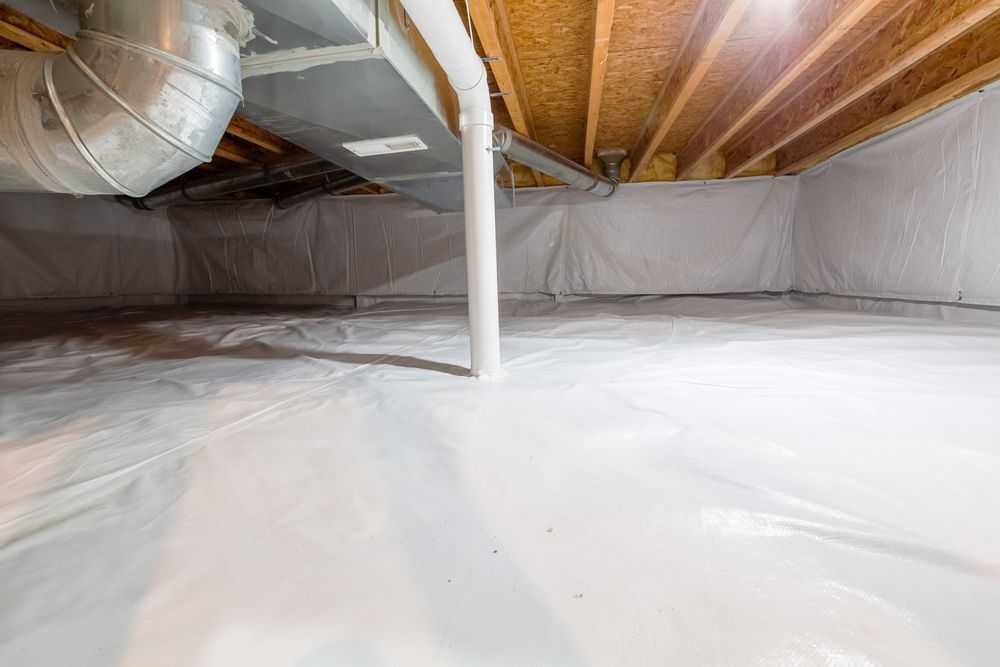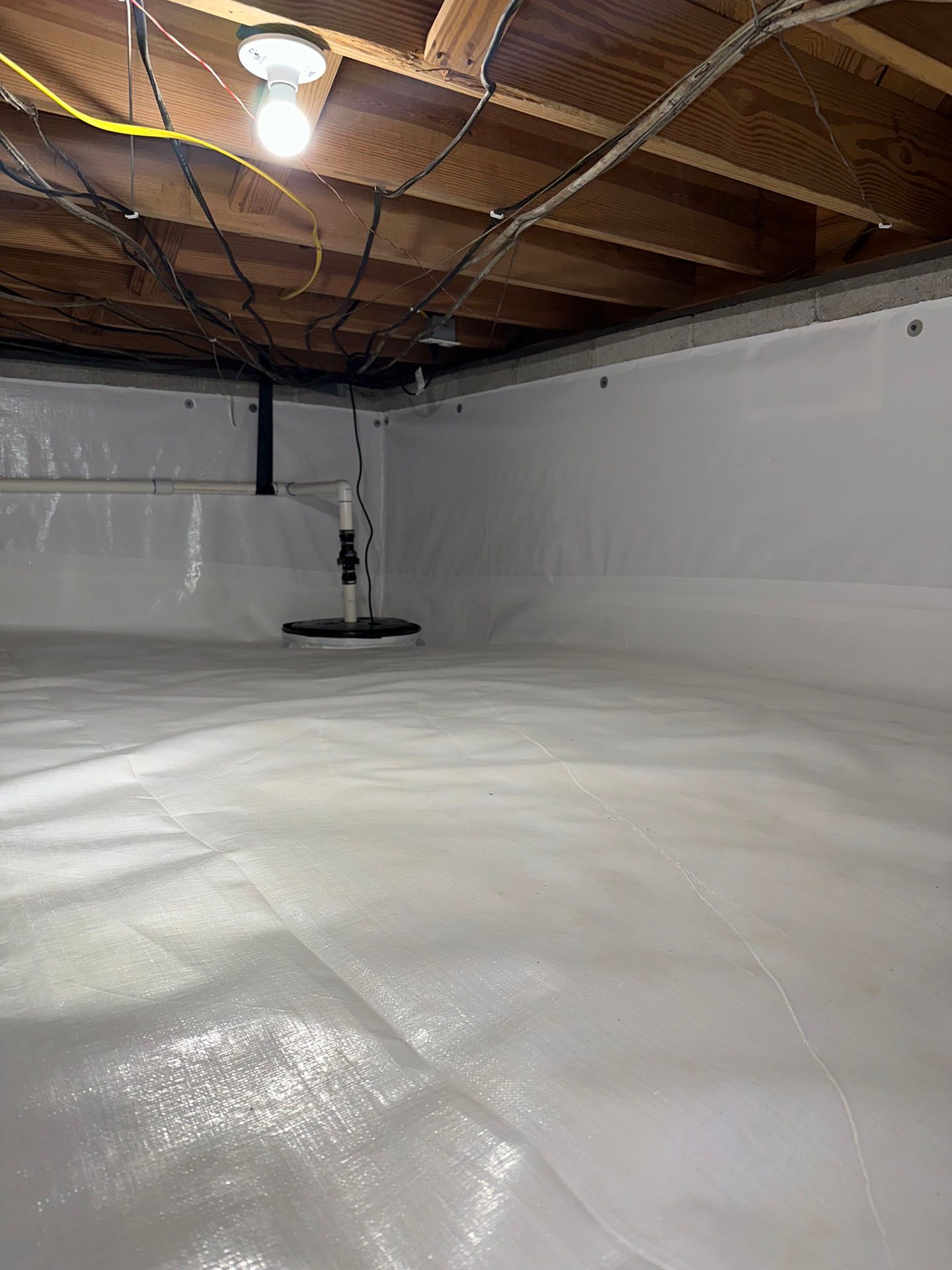Huntsville, Alabama

Claim Your FREE Crawl Space Inspection Today!
Sawyer Williams: 256-727-4422
Schedule Your Free estimate!
No-Obligation, Free Inspections
No-Obligation Free Estimates
We Warranty All of Our Work
100% Satisfaction Guaranteed
Are you finding your crawl space overrun by insects? With summertime quickly approaching, are you concerned that the little critters have taken up residence in your home? Fear not! The good news is there are steps you can take to reclaim your crawl space and regain control. In this post, I’ve put together a step-by-step guide to help you deal effectively with the insects in your crawl space.
No matter how much you might want to just eliminate the problem, you need to avoid the temptation of simply spraying pesticides or using bug bombs. Not only can such solutions be harmful to your health, but these methods rarely address the root cause of the infestation.
Armed with the tips and tricks in this guide, you will be sure to find an effective and safe solution to insects in your crawl space. Keep reading for insider strategies for making your cottage a safe and comfortable environment for you and your family once again.
Quick Insight
The first step is to identify the type of insect, as different species require different treatment methods. Once identified, you should then contact a professional pest control service to eradicate the infestation and discuss next steps for prevention.
Identifying the Insects
The first step in dealing with insects in your crawl space is to accurately identify the type of bug you are dealing with. Knowing the differences between common insects, such as cockroaches, spiders, and rodents, will help you determine which course of action you should take. Different types of insects require different extermination methods, so it’s important to be sure of the type of insect you are dealing with before trying to eradicate them.
Visual inspection is one way to try to identify what kind of insect is present in your crawl space. Examine any cobwebs or entry points for clues about the type and size of insect that may be living in your crawlspace. It can also be helpful to research online for images of common household pests to compare the creature in question to a known database.
If visual inspection is not enough to determine the type of bug, taking a sample or picture to a local pest control professional can be very beneficial. Professional exterminators have access to identification guides and have vast experience in determining an insect’s origin and species. This can give peace of mind when deciding upon an extermination plan as well as save time and money by avoiding unnecessary treatment or sprays that wouldn’t otherwise work.
Armed with knowledge about what type of bug is present, you can now move onto inspecting the crawl space and outlining an extermination plan moving forward.
- Insects found in crawl spaces can contaminate food, surfaces, and air with their droppings and saliva.
- Insects living in a home or attic can cause respiratory problems including asthma and allergies.
- Insect infestation in a crawl space has been linked to an increased risk of contracting vector-borne diseases, such as Lyme disease.
Inspect the Crawl Space
Inspecting the crawl space is a vital step in understanding what type of insect you’re dealing with and how to best eliminate them. Take a careful look around your crawl space for any signs that insects have taken up residence. Common signs include wood damage, cobwebs, droppings, larvae, or eggs. If you notice any of these specific signs, then you know what type of pests you are up against and can understand the necessary steps to take.
Keep an eye out for mud tubes or tunnels as well. These are typically found on foundation walls and along pipes or beems and they can indicate termite activity. It may even be worth calling in an exterminator if any of these signs are present, as they will be able to properly identify the infestation and provide an appropriate treatment plan.
If no obvious signs of insects are noticed upon inspection, that doesn’t necessarily mean they aren’t present. Some insect types may be more difficult to detect at first glance. In that case, there may still be certain preventive measures worth taking (or not taking), such as making sure proper ventilation and drainage is in place so as not to invite moisture-loving insects like silverfish.
Once you have finished inspecting the crawl space, it’s time to determine the source of the problem before taking action to eliminate it. This is discussed in more detail in the following section about Determining The Source.
Essential Points
Inspecting a crawl space for evidence of insect infestation is essential in order to form an appropriate plan for extermination. Red flags include wood damage, cobwebs, droppings, larvae, eggs, and mud tubes or tunnels. If no signs are found, there are still preventative measures worth taking. After inspection, the source of the problem should be determined before any action is taken.
Determining The Source
Before addressing the issue of insects in your crawl space, it is important to identify the source of infestation. Knowing the type and origin of the intruders will help you create an effective plan for getting rid of them. Inspect the area for signs of activity and note any unusual behavior or patterns as this may reveal more information about the sources.
It is also important to inspect the exterior of your home for possible entry points that can allow pests easier access inside. Some common areas for insect entry are around windows, door frames, siding, and foundation walls. Caulking or sealing these openings can prevent future infestations.
Some people question if humidity levels in their homes might be contributing to infestations, but environmental factors like temperature, air flow, and moisture are not necessarily reliable indicators of insect activity. Rather than trying to control environmental conditions, focus on eliminating any potential sources of food or shelter in order to stop current infestations and prevent future ones from occurring.
No matter if you have identified the source or not, it will be helpful to take a few precautionary measures before moving on to your next step. By checking for entry points and moisture buildup around your home you can be sure that you are preventing potential pest problems in the future. Next we will discuss how to check for entry points and moisture buildup to ensure that your crawlspace remains pest-free.
Check for Entry Points and Moisture Buildup
When dealing with insects in your crawl space, it is important to check for entry points and moisture buildup that may be inviting unwanted pests. Your crawl space may have openings where the bugs can enter into your home or cracks in the walls which can allow them to gain access. Additionally, if the area has high humidity, it can attract insects and other pests. In order to prevent further infestations, these areas must be addressed.
It is also recommended to thoroughly inspect your house for any gaps or cracks through which insects could potentially enter. Some common areas where these small openings can be found include windowsills, cracks around door frames, exterior vents and siding, foundation vents, and plumbing connections. These should be caulked or sealed where necessary to keep out unwanted pests. If you find any significant amounts of moisture in the area, that too should be dealt with immediately since this can create an ideal environment for insects to thrive in. You may need to install a dehumidifier to reduce the humidity levels or use fans to circulate air and dry out dampness in the space.
To ensure that you don't have a reoccurring issue with insects in your crawl space, it is essential that you check for any entry points as well as potential sources of moisture buildup. Once these potential entryways are closed off, the next step is deciding on the right treatment to keep these bugs away.
Choosing the Right Treatment
Choosing the right treatment for your crawl space is a critical consideration. Many homeowners opt for over-the-counter pesticides, available at most stores or online. These are usually effective, yet there are drawbacks. For example, bug sprays may introduce hazardous chemicals into the environment, and they may not be as effective as promised due to the size and scope of the infestation.
Another option is natural insecticides, which uses plant-based ingredients such as citrus and cedar oil to deter pests. Although these are generally safe for people and pets to use, they do require multiple applications to provide full pest control coverage in your crawl space.
The most comprehensive solution is professional Integrated Pest Management (IPM), which uses a combination of prevention techniques (such as sealing cracks in foundations) and targeted treatments (such as gels or traps). Professional pesticide applicators know how to discern which insects have invaded your crawl space and can appropriately treat them while minimizing collateral damage to beneficial insects like bees. Professional IPM demands an initial investment of time and money, but it’s almost always the most cost-effective solution in the long run.
No matter which method you choose, keep safety first. Wear proper protection when using insecticides such as gloves, masks and protective eyewear. Ensure kids and animals are not present during treatment before you start.
Now that you have chosen your preferred treatment method, the next step is deciding between professional pest control or DIY solutions.
Professional Pest Control or DIY?
When it comes to dealing with insects in your crawl space, you have two primary options: professional pest control or attempting to do it yourself (DIY). Each of these solutions come with their own pros and cons – so let’s explore them individually.
Professional Pest Control
Calling in an expert is a fast and reliable solution for eliminating insects from your crawl space. Professional pest exterminators are experienced in inspecting any area of a home that can be vulnerable to insect infestations, such as the crawl space. They will also provide long-term plans for proactive pest prevention that can help to keep insects away permanently. The downside to this method is that it’s likely to be expensive and may require multiple treatments before being effective.
DIY Solutions
On the other hand, if you choose to tackle the problem DIY style, there is no cost associated with supplies or with hiring professionals. This does tend to be more of a trial-and-error approach that requires you to closely monitor the situation and take protective measures on your own. Keep in mind though that DIY methods may not be as effective for large infestations and more severe cases of insect problems.
No matter which option you decide to pursue, it’s important to remember that both require patience and attention. While professional services may be more expensive upfront, they often yield better long-term results while reducing time needed for complete elimination of pests in the crawl space. On the other hand, going the DIY route is often cheaper but may take longer than expected.
Now that we’ve explored different approaches to dealing with insects in your crawl space, let’s move onto the next section where we'll discuss how to get rid of pests safely and effectively.
How to Get Rid of Pest Safely
When it comes to getting rid of pests in a crawl space, safety should be the top priority. Not only for people, but for the environment and other animals that may be present in the area. For example, if you have pets, you'll want to avoid using any kind of chemical pest control.
A great way to ensure the safety of both people and pets is to first use mechanical methods to get rid of the pests. Some common methods include vacuuming or traps, as these often don't require any kind of toxins or poisons. If this isn't successful, then you may consider using pesticides or insecticides as a last resort. Although these chemicals can be effective, they come with certain risks that need to be taken into consideration before they are used.
On one side of the argument, there are those who believe that chemical control is necessary when dealing with large infestations or very toxic insects such as termites or fire ants. They argue that chemical control offers a more efficient approach when dealing with large numbers of pests and is often less labor-intensive than manual removal.
On the other side of the argument, opponents stand firm in claiming that chemicals are not only potentially toxic to humans and pets, but also damaging to surrounding ecosystems. They argue that natural methods such as pest-proofing entrances and exits and setting traps are just as effective and much safer for everyone involved.
No matter which approach you take towards getting rid of pests safely in your crawl space, it is important to remember that safety should always come first. Now it's time to consider whether traps or pesticide sprayers are best suited for your specific situation.
Consider Traps and Pesticide Sprayers
When it comes to dealing with insects in your crawl space, traps and pesticide sprayers can be an effective solution. Traps can be placed around the perimeter of the crawl space, to catch any crawling insects or small creatures that make their way inside. Traps are designed to lure insects in with food or attractants, while preventing them from escaping back outside.
On the other hand, those wishing to use pesticide sprayers should consider doing their own research about the types of pests in the area before proceeding. Many pesticides are meant for specific types of insects and could potentially do more harm than good if used on a species that isn’t harmful. If you’re not sure what type of insect you’re dealing with, it’s worth contactng a pest control professional to determine what type of treatment would be most appropriate.
Pest control professionals are also skilled at treating hard-to-reach areas such as crawl spaces and attics. They may have access to more powerful insecticides or other specialty products that could help ensure all the pests are eliminated.
While traps and pesticide sprays can prove effective in dealing with existing insect populations in a crawlspace, it's important to remember that prevention is the best method when it comes to eliminating future infestations. In the next section, we'll discuss some tips on how to keep your crawl space clean and reduced your risk of having recurring issues with insects.
Prevention of Future Infestations
When it comes to keeping insects out of your crawl space in the future, there are two main strategies that homeowners can use to minimize their risk; insect-proofing the environment and drying out the area.
Insect-Proofing the Environment
The most efficient way to prevent future infestations is to invest in insect-proofing the environment. Because insects enter your home through small cracks, crevices, and other access points, it's important to seal up all potential entrances. Examples include: caulking around windowsills, sealing doors and vents with weatherstripping, replacing door sweeps, and making sure that any gaps between floors or walls are sealed shut. Additionally, reducing vegetation around your home helps decrease potential entry points for pests. This can be done by trimming trees and shrubs back from the foundation or eliminating woodpiles and compost piles near your home.
Drying Out the Space
Another preventive measure is to dry out damp spaces like crawl spaces as moisture often attracts pests such as beetles and roaches. To dry out a damp crawl space, you should use a dehumidifier to reduce humidity levels which can also help bring down mold growth. You should also make sure that your water lines are well insulated so they don’t sweat or cause condensation on the floor or wall. Additionally, waterproofing the perimeter of the basement may be necessary if you have high groundwater levels that result in flooding or pooling water in certain areas of your basement.
These preventive measures should provide you with peace of mind when it comes to keeping insects out of your crawl space. However, depending on your pest problem, you might want to consider hiring a professional exterminator for more effective results. With that said, let's move on to the next section which will cover insect-proofing the environment and drying out the space.
Insect-Proofing the Environment and Dry Out the Space
Insect-proofing the environment and drying out the space are vital steps in eliminating pests in crawl spaces. Insect-proofing the environment will reduce or eliminate the pests, while drying out the space will prevent infestations from occurring in the future.
In order to insect-proof the environment, it is important to inspect and seal any holes, crevices and cracks in your crawl space -- especially those that lead to other zones of your home. Sealing these openings will help to deny entry for potential pests. Additionally, it is also important to clear away dead foliage and remove any standing water or accumulating moisture that may be acting as a pest attractant. Consider installing vents or tunnels in order to improve air flow and circulation; this will not only reduce humidity but can also help keep pests from entering.
When it comes to drying out your crawl space, there are several strategies you can try. The use of dehumidifiers is one of the most effective methods for drying out a wet crawl space. These devices draw moisture from the air and can store it as condensate or transfer it as splashback into a sump pump located outside your house. It is important to remember that dehumidifiers should only be used if there is no structural damage present in the crawl space; otherwise, they will not be effective at reducing moisture levels. Additionally, you should consider improving insulation around your foundation walls to further help with moisture control and eliminate warm, humid conditions conducive to insect reproduction and activity.
You can also create a barrier between your home’s interior living space and your crawl space by applying a vapor barrier on top of the soil within your crawl space. This will help prevent moist air from rising into your home’s living area, reducing humidity levels within both spaces. Keeping both areas dry is key for discouraging insect intrusions.
Remember: insect-proofing the environment and drying out the space are essential steps for controlling insect infestations in crawl spaces. It is necessary to ensure sealed openings are present both inside and outside of your home’s foundation walls, along with improved air flow and insulation for an effective means of controlling insects and preventing future infestations.
Common Questions Explained
Is it safe to remove the insects myself or is it best to hire an exterminator?
It depends on the type of insect infestation you have. If the infestation is minor or localized, then it may be safe to attempt removal yourself. Consider purchasing a safer insecticide specifically designed for your crawl space and use gloves and a face mask when applying. However, if the infestation is widespread or if it is too difficult to identify all of the insects in your crawl space, it would be safest to hire an exterminator with experience in dealing with crawl spaces. An exterminator will be able to correctly identify the infestation, eliminate any hazardous insects and advise on how to prevent future infestations.
Are there any specific species of insects that commonly live in crawl spaces?
Yes, there are several species of insects that commonly live in crawl spaces, including spiders, centipedes, earwigs, silverfish, and ants. These insects love dark moist places to hide and a crawl space provides them with the perfect habitat.
Spiders usually inhabit the corners of the crawl space or behind boxes since they can spin webs quickly and easily. Centipedes feed on other small bugs and can be identified by their many legs. Earwigs like dark secluded places where they can build nests and feed on plant material. Silverfish like areas that are moisture rich and are especially fond of eating paper products. Lastly, ants will often build colonies in damp places and reproduce very rapidly if left unchecked.
It’s important to note that depending on the climate you live in some species of insects may not be found in your area or thrive as successfully due to environmental factors, it therefore is a good practice to have someone inspect your crawl space who would know what types of insects inhabit the region prior to formulating a pest control plan.
What measures can I take to prevent insects from entering my crawl space?
1. Make sure to keep your crawl space as dry and clean as possible. Any standing water or debris can attract insects. Consider using a dehumidifier to reduce humidity and humidity levels, which will make the area less inviting to them.
2. Seal all potential entry points with caulk, steel wool, or other insect-proofing materials. Check your foundation walls, exterior doors, window frames, and other vulnerable areas for gaps and cracks that might let pests in.
3. Use a preventive pesticide spray around the perimeter of your crawl space. Choose an insecticide labeled for use in confined spaces, but be sure to follow the product’s instructions carefully so you don’t create an unsafe environment for yourself or other occupants.
4. Install appropriate screens on vents and openings leading into the crawl space to keep out flying insects and rodents. You should also check these regularly for wear and tear so they are always effective at keeping out pests.
5. Investigate whether there may be underlying causes drawing pests into your crawl space such as exposed food or water sources nearby. If there are any issues causing the problem, it will need to be addressed before you can adequately keep the walls of your crawlspace pest-free.

Written by Sawyer Williams
Precision Crawlspace & Renovations
Sawyer has specialized in crawl space and foundation repairs for over six years. As the founder of Precision Crawlspace and Renovations, he is one of Huntsville's top experts in crawlspace moisture control. He has prior experience installing these systems, which has prepared him to solve complex problems related to crawl space encapsulation, mold remediation, and waterproofing.
Recent Blog Posts
Huntsville's Crawl Space News



What are you waiting for?
We Solve Crawl Space Issues!
Get reliable crawl space repair services at an affordable price, provided with the high level of service you deserve.
Call Us Today at: 256-727-4422
All Rights Reserved | Precision Crawlspace & Renovations

